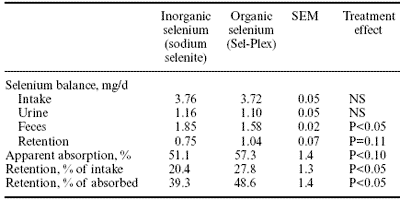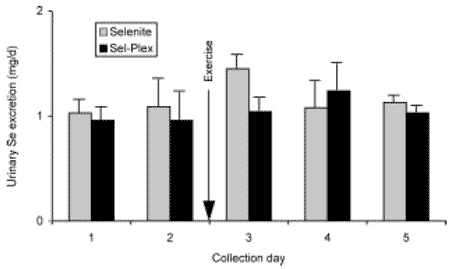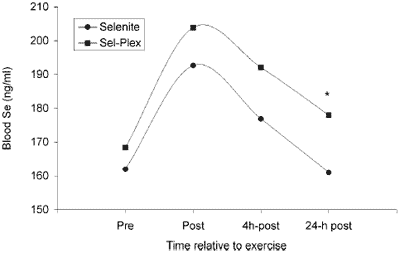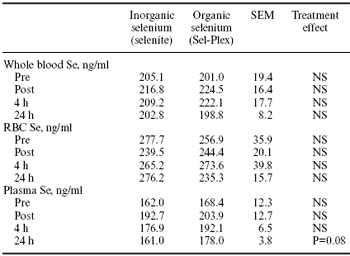Effect of selenium source on selenium digestibility and retention in exercised Thoroughbreds
Published: June 19, 2007
By: J.D. PAGAN, P. KARNEZOS, M.A.P. KENNEDY, T. CURRIER, and K.E. HOEKSTRA (Courtesy of Alltech Inc.)
Performance horses compete in a wide variety of athletic events ranging from high speed racing to 100-mile endurance rides. These types of exercise are known to induce oxidative stress, leading to the generation of free radicals.
An increased generation of free radicals may induce lipid peroxidation and tissue damage in both the respiratory system and working muscle. This is particularly true if the animal has a deficient or impaired antioxidant status. Reddy et al. (1998) studied the role of vitamin E and selenium during exercise-induced oxidative stress in the pulmonary tissue of rats.
Vitamin E and/or selenium deficiency resulted in generation of free radicals as revealed by electron spin resonance (ESR) spectra in lung tissue, indicating the onset of oxidative stress. When the rats were subjected to a single bout of exhaustive exercise, there was an additional increase in the generation of oxygen free radicals.
However, no such signals were recorded in the lung tissue of vitamin E and selenium-supplemented animals when subjected to a similar exercise program, suggesting that protection is offered by vitamin E and selenium in combating oxidative stress. Many antioxidants, including glutathione peroxidase (GSH-Px), are selenoproteins making selenium an extremely important mineral for performance horses.
Although the Food and Drug Administration (FDA) has approved maximal selenium supplementation at 0.3 mg/kg of dry matter in complete feeds for cattle, sheep, and swine (FDA, 1987), selenium supplementation of equine feeds is restricted only by nutritional recommendations and industry practices (NRC, 1989).
The selenium requirement for mature idle horses was estimated by theNRC to be 0.1 mg/kg of diet. This requirement is based on studies that evaluated the relationship between selenium intake and blood selenium in mature idle horses (NRC, 1989).
Shelle et al. (1985) investigated the effect of supplemental selenium on plasma selenium and on glutathione peroxidase in Arabian and crossbred horses subjected to a conditioning program. They reported that conditioning increased erythrocyte glutathione peroxidase activity and suggested that horses at high work intensities may have higher requirements for selenium than the 0.1 ppm requirement suggested by the NRC.
Stowe (1998) has suggested that the appropriate concentration of selenium in the total diet of a horse is 0.3 ppm. This would mean that if a concentrate mix was 50% of the diet and the forage component of the diet supplied 0.06 ppm Se, the grain mix would need to be roughly 0.6 ppm.
Selenium in forages and seed grains is normally present as organic selenium in the form of selenocystine, selenocysteine, and selenomethionine. Sodium selenite and sodium selenate are common inorganic sources of supplemental selenium for horses; and evidence in horses (Podoll et al., 1992) indicates there is no difference between them in potency as measured by blood selenium status.
Measurement in laboratory animals, however, shows that organic plant sources of selenium are more potent than inorganic (Frape, 1998). No studies have measured the digestibility and retention of selenium from different selenium sources in horses. Therefore, the following study was conducted to evaluate how exercised Thoroughbreds digest and retain selenium from either sodium selenite or organic selenium from yeast.
Materials and methods
Four mature trained Thoroughbred geldings were used in a two-period switch back design trial. During each period, two horses were fed hay and unfortified concentrate supplemented daily with 2.90 mg of selenium from sodium selenite. Selenite-supplemented rations averaged 0.41 ppm Se with ~77% of the total selenium provided by the selenite. The other two horses received hay and unfortified concentrate supplemented daily with 2.76 mg of organic selenium from a selenium yeast (Sel-Plex, Alltech, Inc.). Organic selenium rations averaged 0.40 ppm Se with ~75% of the total selenium provided from the yeast.
During period 1, the horses were fed the selenium supplemented diets for five weeks. During the first four weeks, the horses were exercised three days per week on a high speed treadmill and three days per week on a mechanical horse walker. The horses were housed in box stalls at night and were turned out into paddocks during the day with muzzles to prevent grazing.
During week 5 of period 1, a five-day complete collection digestion trial was conducted. The horses were fitted with collection harnesses that allowed the complete and separate collection of feces and urine. Daily fecal and urinary output was measured and daily samples of each were frozen for later selenium analysis.
On day three of the digestion trial, the horses completed a competition exercise test (CET) on the high speed treadmill which was designed to simulate the physiological and metabolic stresses of the speed and endurance test of a three-day event (Marlin et al., 1995).
The CET was performed on an inclined treadmill (3°) and consisted of a 10-minute walk (Phase A, 1.4 m/s), 10-minute trot (Phase A, 3.7 m/s), 2-minute gallop (Phase B, 10.7 m/s), 20-minute trot (Phase C, 3.7 m/s), 10-minute walk (Phase C, 1.4 m/s) and 8-minute canter (Phase D, 9.0 m/s).
Following exercise, the horses were hand-walked for an additional 30 minutes.Whole blood and plasma samples were taken from the horses immediately before and after the CET and 4 hrs and 24 hrs post-exercise. Packed cell volume (PCV) was measured in each blood sample using a Coulter Counter S560 (Coulter Electronics, Hialeah, FL, USA).
Feed, feces, urine and blood were analyzed for selenium according to the fluorometric method of AOAC (1995). Red blood cell (RBC) selenium was calculated using the following equation:
RBC Se = [Whole blood Se-(plasma Se*(1-PCV))]/PCV.
Following period 1, the selenium supplementation received by each horse was switched for an additional three week period. During the first two weeks of period 2, the horses followed the same exercise schedule as they had during period 1 followed by a complete collection digestion trial and CET during week 3. The digestibility and retention of selenium from the two supplements were calculated and compared using least squares analyses of variance with general linear models procedures. Data were analyzed using a model that included horse, period and treatment as main effects.
Results and discussion
SELENIUM DIGESTIBILITY AND RETENTION
Horses supplemented with inorganic selenium excreted more fecal selenium than when supplemented with Sel-Plex Se (P<0.05) (Table 1). The apparent absorption of selenite selenium and Sel-Plex selenium averaged 51.1% and 57.3%, respectively. These digestibility values are intermediate between those reported for pigs and ruminants. In ruminants, selenium absorption is around 35% while in pigs, absorption values of 75-85% have been reported (Levander, 1986). Mahan and Parrett (1996) measured selenium digestibility in growing pigs weighing around 52 kg. They found that the apparent selenium digestibility of both selenite and organic selenium averaged about 75% when fed at supplemental levels of 0.3 ppm.
Selenium retention was increased when Sel-Plex was the added dietary selenium source (P<0.05). Most of the difference in selenium retention was the result of increased selenium absorption since there was no difference in average daily urinary selenium excretion between the two supplemental sources. Mahan and Parrett (1996) also found increased selenium retention with Sel-Plex in growing pigs; but in contrast to the present study, the difference was due to increased urinary excretion of selenium in the selenite-supplemented animals.
While average daily urinary selenium excretion was not different between treatments, selenium excretion following a bout of exercise was affected by selenium source. The horses completed the competition exercise test (CET) on the morning of day 3 of the five-day collection. Following exercise, selenium excretion in horses given inorganic selenium was higher than during day 1 or day 2 of the collection period (P<0.01) (Figure 1). A similar increase in excretion did not occur when horses were given organic selenium and during day 3 urinary selenium excretion was lower in the Sel-Plex group compared to the horses given selenite (P=0.06).
Table 1. Effect of selenium source on balance measurements in exercised horses.

WHOLE BLOOD AND PLASMA SELENIUM
Before exercise, mean plasma values were slightly higher than reference values reported by Stowe and Herdt (1992), but similar to values reported by Shelle et al. (1985) and Snow et al. (1987) (Table 2, Figure 2). Whole blood values were typical for horses receiving selenium supplementation (Shellow et al., 1985; Stowe and Herdt, 1992). Both plasma and whole blood selenium increased post-exercise (P<0.01).

Figure 1. Effect of selenium source on daily urinary selenium excretion.

Figure 2. Plasma selenium before and after competition exercise test.
Table 2. Blood selenium before and after the competition exercise test.

This agrees with Gallagher and Stowe (1980) who reported an increase in serum selenium following a training jog in 45 Standardbred horses.
Red blood cell selenium was similar between treatment groups and there was a trend towards a decrease in RBC selenium post-exercise. Plasma selenium remained elevated in both treatments four hours post-exercise (P<0.05).
By 24 hrs post-exercise, the plasma selenium in horses given inorganic selenium had returned to pre-exercise levels, while plasma selenium from the Sel-Plex-supplemented group remained elevated. At this time, plasma selenium in horses given Sel-Plex was higher than in the horses given selenite (P=0.08).
An increased generation of free radicals may induce lipid peroxidation and tissue damage in both the respiratory system and working muscle. This is particularly true if the animal has a deficient or impaired antioxidant status. Reddy et al. (1998) studied the role of vitamin E and selenium during exercise-induced oxidative stress in the pulmonary tissue of rats.
Vitamin E and/or selenium deficiency resulted in generation of free radicals as revealed by electron spin resonance (ESR) spectra in lung tissue, indicating the onset of oxidative stress. When the rats were subjected to a single bout of exhaustive exercise, there was an additional increase in the generation of oxygen free radicals.
However, no such signals were recorded in the lung tissue of vitamin E and selenium-supplemented animals when subjected to a similar exercise program, suggesting that protection is offered by vitamin E and selenium in combating oxidative stress. Many antioxidants, including glutathione peroxidase (GSH-Px), are selenoproteins making selenium an extremely important mineral for performance horses.
Although the Food and Drug Administration (FDA) has approved maximal selenium supplementation at 0.3 mg/kg of dry matter in complete feeds for cattle, sheep, and swine (FDA, 1987), selenium supplementation of equine feeds is restricted only by nutritional recommendations and industry practices (NRC, 1989).
The selenium requirement for mature idle horses was estimated by theNRC to be 0.1 mg/kg of diet. This requirement is based on studies that evaluated the relationship between selenium intake and blood selenium in mature idle horses (NRC, 1989).
Shelle et al. (1985) investigated the effect of supplemental selenium on plasma selenium and on glutathione peroxidase in Arabian and crossbred horses subjected to a conditioning program. They reported that conditioning increased erythrocyte glutathione peroxidase activity and suggested that horses at high work intensities may have higher requirements for selenium than the 0.1 ppm requirement suggested by the NRC.
Stowe (1998) has suggested that the appropriate concentration of selenium in the total diet of a horse is 0.3 ppm. This would mean that if a concentrate mix was 50% of the diet and the forage component of the diet supplied 0.06 ppm Se, the grain mix would need to be roughly 0.6 ppm.
Selenium in forages and seed grains is normally present as organic selenium in the form of selenocystine, selenocysteine, and selenomethionine. Sodium selenite and sodium selenate are common inorganic sources of supplemental selenium for horses; and evidence in horses (Podoll et al., 1992) indicates there is no difference between them in potency as measured by blood selenium status.
Measurement in laboratory animals, however, shows that organic plant sources of selenium are more potent than inorganic (Frape, 1998). No studies have measured the digestibility and retention of selenium from different selenium sources in horses. Therefore, the following study was conducted to evaluate how exercised Thoroughbreds digest and retain selenium from either sodium selenite or organic selenium from yeast.
Materials and methods
Four mature trained Thoroughbred geldings were used in a two-period switch back design trial. During each period, two horses were fed hay and unfortified concentrate supplemented daily with 2.90 mg of selenium from sodium selenite. Selenite-supplemented rations averaged 0.41 ppm Se with ~77% of the total selenium provided by the selenite. The other two horses received hay and unfortified concentrate supplemented daily with 2.76 mg of organic selenium from a selenium yeast (Sel-Plex, Alltech, Inc.). Organic selenium rations averaged 0.40 ppm Se with ~75% of the total selenium provided from the yeast.
During period 1, the horses were fed the selenium supplemented diets for five weeks. During the first four weeks, the horses were exercised three days per week on a high speed treadmill and three days per week on a mechanical horse walker. The horses were housed in box stalls at night and were turned out into paddocks during the day with muzzles to prevent grazing.
During week 5 of period 1, a five-day complete collection digestion trial was conducted. The horses were fitted with collection harnesses that allowed the complete and separate collection of feces and urine. Daily fecal and urinary output was measured and daily samples of each were frozen for later selenium analysis.
On day three of the digestion trial, the horses completed a competition exercise test (CET) on the high speed treadmill which was designed to simulate the physiological and metabolic stresses of the speed and endurance test of a three-day event (Marlin et al., 1995).
The CET was performed on an inclined treadmill (3°) and consisted of a 10-minute walk (Phase A, 1.4 m/s), 10-minute trot (Phase A, 3.7 m/s), 2-minute gallop (Phase B, 10.7 m/s), 20-minute trot (Phase C, 3.7 m/s), 10-minute walk (Phase C, 1.4 m/s) and 8-minute canter (Phase D, 9.0 m/s).
Following exercise, the horses were hand-walked for an additional 30 minutes.Whole blood and plasma samples were taken from the horses immediately before and after the CET and 4 hrs and 24 hrs post-exercise. Packed cell volume (PCV) was measured in each blood sample using a Coulter Counter S560 (Coulter Electronics, Hialeah, FL, USA).
Feed, feces, urine and blood were analyzed for selenium according to the fluorometric method of AOAC (1995). Red blood cell (RBC) selenium was calculated using the following equation:
RBC Se = [Whole blood Se-(plasma Se*(1-PCV))]/PCV.
Following period 1, the selenium supplementation received by each horse was switched for an additional three week period. During the first two weeks of period 2, the horses followed the same exercise schedule as they had during period 1 followed by a complete collection digestion trial and CET during week 3. The digestibility and retention of selenium from the two supplements were calculated and compared using least squares analyses of variance with general linear models procedures. Data were analyzed using a model that included horse, period and treatment as main effects.
Results and discussion
SELENIUM DIGESTIBILITY AND RETENTION
Horses supplemented with inorganic selenium excreted more fecal selenium than when supplemented with Sel-Plex Se (P<0.05) (Table 1). The apparent absorption of selenite selenium and Sel-Plex selenium averaged 51.1% and 57.3%, respectively. These digestibility values are intermediate between those reported for pigs and ruminants. In ruminants, selenium absorption is around 35% while in pigs, absorption values of 75-85% have been reported (Levander, 1986). Mahan and Parrett (1996) measured selenium digestibility in growing pigs weighing around 52 kg. They found that the apparent selenium digestibility of both selenite and organic selenium averaged about 75% when fed at supplemental levels of 0.3 ppm.
Selenium retention was increased when Sel-Plex was the added dietary selenium source (P<0.05). Most of the difference in selenium retention was the result of increased selenium absorption since there was no difference in average daily urinary selenium excretion between the two supplemental sources. Mahan and Parrett (1996) also found increased selenium retention with Sel-Plex in growing pigs; but in contrast to the present study, the difference was due to increased urinary excretion of selenium in the selenite-supplemented animals.
While average daily urinary selenium excretion was not different between treatments, selenium excretion following a bout of exercise was affected by selenium source. The horses completed the competition exercise test (CET) on the morning of day 3 of the five-day collection. Following exercise, selenium excretion in horses given inorganic selenium was higher than during day 1 or day 2 of the collection period (P<0.01) (Figure 1). A similar increase in excretion did not occur when horses were given organic selenium and during day 3 urinary selenium excretion was lower in the Sel-Plex group compared to the horses given selenite (P=0.06).
Table 1. Effect of selenium source on balance measurements in exercised horses.

WHOLE BLOOD AND PLASMA SELENIUM
Before exercise, mean plasma values were slightly higher than reference values reported by Stowe and Herdt (1992), but similar to values reported by Shelle et al. (1985) and Snow et al. (1987) (Table 2, Figure 2). Whole blood values were typical for horses receiving selenium supplementation (Shellow et al., 1985; Stowe and Herdt, 1992). Both plasma and whole blood selenium increased post-exercise (P<0.01).

Figure 1. Effect of selenium source on daily urinary selenium excretion.

Figure 2. Plasma selenium before and after competition exercise test.
Table 2. Blood selenium before and after the competition exercise test.

This agrees with Gallagher and Stowe (1980) who reported an increase in serum selenium following a training jog in 45 Standardbred horses.
Red blood cell selenium was similar between treatment groups and there was a trend towards a decrease in RBC selenium post-exercise. Plasma selenium remained elevated in both treatments four hours post-exercise (P<0.05).
By 24 hrs post-exercise, the plasma selenium in horses given inorganic selenium had returned to pre-exercise levels, while plasma selenium from the Sel-Plex-supplemented group remained elevated. At this time, plasma selenium in horses given Sel-Plex was higher than in the horses given selenite (P=0.08).
| Conclusions The digestibility of selenium in horses appears to be intermediate between ruminants and nonruminants. Selenium from yeast was more digestible than from sodium selenite, leading to a greater positive selenium balance in these horses. The level of selenium supplementation in this study was probably above the horse’s requirement since every horse was in positive selenium balance and blood selenium values were on the high side of normal reference ranges. Since only one level of selenium was fed, it is not possible to establish a selenium requirement from these data. Increased urinary selenium excretion following exercise in the inorganic selenium group suggests that the requirement for selenium by exercised horses may be dependent on selenium source and exercise frequency. The exercise intensity used in this study resulted in an increase in plasma selenium in both treatment groups. The source of this increased plasma selenium may have been the red blood cells, since there was a trend towards lower RBC selenium following exercise. Following exercise, plasma selenium in those fed the inorganic source returned to pre-exercise levels while plasma selenium in those given Sel-Plex remained elevated at 24 hrs postexercise. Perhaps part of the selenium that mobilized from the RBC in the selenite group during exercise was voided in the urine, leading to an increase in urinary selenium excretion during the subsequent 24 hr collection period. After absorption, red blood cells take up inorganic selenium and return it to plasma in the reduced (i.e., hydrogen selenide) form, where it binds to plasma proteins and is transported to the liver to become part of the selenium pool for selenoprotein formation (Combs and Combs, 1986). Some travels to the kidney and is excreted via urine. Organic selenium (selenoamino acids) travels in the blood by amino acid transport mechanisms and is less likely to be lost through urinary excretion. More research is needed to quantify the selenium requirement of horses at different exercise intensities and to determine how the form of dietary selenium affects antioxidant status. |
References
AOAC. 1995. Official Methods of Analysis (16th Ed.). Association of Official Analytical Chemists, Arlington, VA.
Combs,G.F. and S.B. Combs. 1986. Absorption and transfer. In: The Role of Selenium in Nutrition. Academic Press, New York.
Food and Drug Administration. 1987. Food additives permitted in feed and drinking water of animals. Fed. Reg. 52 (Part 573, No. 65):10887.
Frape,D. 1998. Equine Nutrition and Feeding. (2nd Ed.). Blackwell Science Ltd, UK.
Gallagher, K. and H.D. Stowe. 1980. Influence of exercise on serum selenium and peroxide reduction system of racing Standardbreds. Sm. J. Vet. Res. 41:1333.
Levander, O.A. 1986. Selenium. In: Trace Elements in Human and Animal Nutrition Vol. 2 (5th Ed.). (W.Mertz, ed.). Academic Press, Inc.Orlando, FL. pp 209-279.
Mahan,D.C. andN.A. Parrett. 1996. Evaluating the efficacy of Se-enriched yeast and sodium selenite on tissue Se retention and serum GSH-Px activity in grower and finisher swine. J. Anim. Sci. 74: 2967-2974.
Marlin,D.J., C.M. Scott, R.C. Harris,R.C. Schroter, P.C.Mills, P.A.Harris, C.E. Orme, C.A. Roberts, C. Marr, and F. Barrelet. 1995. Physiological responses of non-heat acclimated horses performing treadmill exercise in cool (20°C/40% RH), hot/dry (30°/40% RH) or hot/humid (30°/80% RH) conditions. Equine Vet J., Suppl. 22.
NRC. 1989. Nutrient Requirements of Horses, (5th Ed.). National Academy Press, Washington, DC.
Podoll, K.L., J.B. Bernard, D.E. Ullrey, S.R. DeBar, P.K. Ku and W.T. Magee. 1992. Dietary selenate versus selenite for cattle, sheep, and horses. J. Anim. Sci. 70:1965-1970.
Reddy, K.V., T.C. Kumar,M. Prasad and P. Reddanna. 1998. Pulmonary lipid peroxidation and antioxidant defenses during exhaustive physical exercise: The role of vitamin E and selenium. Nutrition 14(5):448-51.
Shelle, J.E.,W.D. Vanhuss, J.S. Rook and D.E. Ullrey.1985. Relationship between selenium and vitamin E nutrition and exercise in horses. In: Proc. 9th Equine Nutr. And Physiol. Soc. Symp., Lansing, MI. pp 104-109.
Shellow, J.S., S.G. Jackson, J.P. Baker and A.H. Cantor. 1985. The influence of dietary selenium levels on blood levels of selenium and glutathione peroxidase activity in the horse. J. Anim. Sci. 61:590.
Snow, D.H., S.P. Gash,.and D. Rice. 1987. Field observations on selenium status, whole blood glutathione peroxidase and plasma gammaglutamyl transferase activities in thoroughbred racehorses. In: Gillespie and Robinson (Ed.). Equine Exercise Physiology 2. ICEEP Publications, Davis, CA. pp 494-505.
Stowe, H.D. 1998. Selenium supplementation for horse feed. In: Advances in Equine Nutrition. (J.D. Pagan, ed.) Nottingham University Press, UK. pp 97-103.
Stowe, H.D. and T.H. Herdt. 1992. Clinical assessment of selenium status of livestock. J. Anim. Sci. 70:3928-3933.
Authors: J.D. PAGAN1, P. KARNEZOS2, M.A.P. KENNEDY, T. CURRIER1, and K.E. HOEKSTRA1
1 Kentucky Equine Research, Inc., Versailles, Kentucky,
2 Alltech, Inc., Nicholasville, Kentucky, USA
1 Kentucky Equine Research, Inc., Versailles, Kentucky,
2 Alltech, Inc., Nicholasville, Kentucky, USA
Related topics:
Recommend
Comment
Share
11 de junio de 2014
There are various benefite the impact of selenium resource Some of the primary components involved in them are Supplement A, Zinc oxide, Supplement C, Selenium and birdwatcher to name a few. http://www.appliedspeciation.com
Recommend
Reply

Would you like to discuss another topic? Create a new post to engage with experts in the community.
